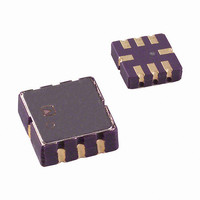ADXL311JE-REEL Analog Devices Inc, ADXL311JE-REEL Datasheet - Page 9

ADXL311JE-REEL
Manufacturer Part Number
ADXL311JE-REEL
Description
IC ACCELER DUAL-AX 2.0G 8PLCC
Manufacturer
Analog Devices Inc
Series
iMEMS®r
Datasheet
1.ADXL311EB.pdf
(12 pages)
Specifications of ADXL311JE-REEL
Axis
X, Y
Acceleration Range
±2g
Sensitivity
174mV/g
Voltage - Supply
2.4 V ~ 5.25 V
Output Type
Analog
Bandwidth
10Hz ~ 500Hz Selectable
Mounting Type
Surface Mount
Package / Case
8-CLCC
Lead Free Status / RoHS Status
Lead free / RoHS Compliant
Interface
-
Available stocks
Company
Part Number
Manufacturer
Quantity
Price
Company:
Part Number:
ADXL311JE-REEL
Manufacturer:
CAN
Quantity:
8 099
Part Number:
ADXL311JE-REEL
Manufacturer:
ADI/亚德诺
Quantity:
20 000
The output of the ADXL311 has a typical bandwidth of 3 kHz.
The user must filter the signal at this point to limit aliasing
errors. The analog bandwidth must be no more than half the
A/D sampling frequency to minimize aliasing. The analog
bandwidth can be further decreased to reduce noise and
improve resolution.
The ADXL311 noise has the characteristics of white Gaussian
noise that contribute equally at all frequencies and are described
in terms of µg/√ Hz , i.e., the noise is proportional to the square
root of the bandwidth of the accelerometer. It is recommended
that the user limits the bandwidth to the lowest frequency
needed by the application to maximize the resolution and
dynamic range of the accelerometer.
With the single-pole roll-off characteristic, the typical noise of
the ADXL311 is determined by
At 100 Hz the noise will be
Often the peak value of the noise is desired. Peak-to-peak noise
can only be estimated by statistical methods. Table 6 shows the
probabilities of exceeding various peak values, given the rms value.
Table 6. Estimation of Peak-to-Peak Noise
Peak-to-Peak
Value
2 × rms
4 × rms
6 × rms
8 × rms
The peak-to-peak noise value gives the best estimate of the
uncertainty in a single measurement. Table 7 gives the typical
noise output of the ADXL311 for various C
Table 7. Filter Capacitor Selection, C
Bandwidth
(Hz)
10
50
100
500
USING THE ADXL311 WITH OPERATING
VOLTAGES OTHER THAN 3 V
The ADXL311 is tested and specified at V
be powered with V
performance parameters change as the supply voltage varies.
RMS
RMS
C
(µF)
0.47
0.1
0.047
0.01
Noise
Noise
X
, C
% of Time That Noise Exceeds Nominal
Peak-to-Peak Value
32
4.6
0.27
0.006
DD
Y
as low as 2.4 V, or as high as 5.25 V. Some
=
=
(
(
300
300
RMS Noise
(mg)
1.2
2.7
3.8
8.5
µ
µ
g
g
/
/
Hz
Hz
) (
) (
×
×
X
and C
Peak-to-Peak Noise
Estimate (mg)
7.2
16.2
22.8
51
DD
100
BW
X
= 3 V; however, it can
and C
×
Y
×
1
1
6 .
6 .
)
Y
)
=
values.
3
8 .
m
g
Rev. B | Page 9 of 12
The ADXL311 output is ratiometric, so the output sensitivity
(or scale factor) varies proportionally to the supply voltage. At
V
The 0 g bias output is also ratiometric, so the 0 g output is
nominally equal to V
The output noise is not ratiometric, but absolute in volts;
therefore, the noise density decreases as the supply voltage
increases. This is because the scale factor (mV/g) increases
while the noise voltage remains constant.
The self-test response is roughly proportional to the square of
the supply voltage. At V
approximately equivalent to 750 mg (typical).
The supply current increases as the supply voltage increases.
Typical current consumption at V
USING THE ADXL311 AS A DUAL-AXIS
TILT SENSOR
One of the most popular applications of the ADXL311 is tilt
measurement. An accelerometer uses the force of gravity as an
input vector to determine the orientation of an object in space.
An accelerometer is most sensitive to tilt when its sensitive axis
is perpendicular to the force of gravity, i.e., parallel to the earth’s
surface. When the accelerometer is oriented parallel to the gravity
vector, i.e., near its +1 g or –1 g reading, the change in output
acceleration per degree of tilt is negligible. When the acceler-
ometer is perpendicular to gravity, its output changes nearly
17.5 mg per degree of tilt, but at 45° degrees, it changes only
12.2 mg per degree, and resolution declines.
Dual-Axis Tilt Sensor: Converting
Acceleration to Tilt
When the accelerometer is oriented so both its X-axis and Y-axis
are parallel to the earth’s surface, it can be used as a two-axis tilt
sensor with a roll axis and a pitch axis. Once the output signal
from the accelerometer has been converted to an acceleration
that varies between –1 g and +1 g, the output tilt in degrees is
calculated as follows:
Be sure to account for overranges. It is possible for the
accelerometers to output a signal greater than ±1 g due to
vibration, shock, or other accelerations.
DD
= 5 V, the output sensitivity is typically 312 mV/g.
Pitch
Roll
=
=
A
A
SIN
SIN
DD
(
A
/2 at all supply voltages.
(
A
DD
Y
X
1 /
= 5 V, the self-test response is
1 /
g
g
)
)
DD
= 5 V is 750 µA.
ADXL311














